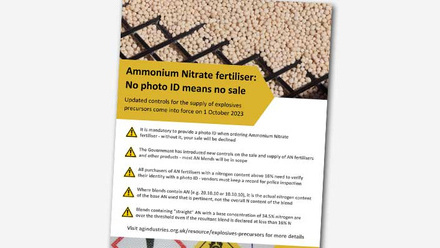FAQs: Explosives Precursors Regulations and guidance
Updated legislation from 1 October 2023
The Control of Poisons and Explosives Precursors Regulations 2023 introduces new substances to the list of regulated explosives precursors and poisons.
The Home Office amended the Control of Poisons and Explosives Precursors Regulations made under the Poisons Act 1972 to introduce new substances to the lists of regulated explosives precursors and poisons.
Offences relating to the acquisition, importation, supply, possession and use of the following substances have been added and took effect from 1 October 2023.
The list of chemicals falling under this legislation together with the concentration threshold is available in the Government guidance on the GOV.UK website.
For fertilisers, Participants who comply with the FIAS Standard already meet most of the new regulation's requirements.
However, there are some additional requirements that apply to suppliers of fertiliser materials to businesses or to professional end users.
Click below to view related content.
Photo ID requirement
- From 1 October, businesses supplying regulated substances to professional users and other businesses must (as for the requirements for ammonium nitrate) obtain photographic ID of the business customer.
- The business name and address, VAT number and the nature of the business must also be held by the supplier.
Reporting
For both regulated substances and reportable substances from 1 October:
- Any suspicious transactions or attempted transactions (business to consumer and business to business) must be reported within 24 hours
This can be done via the online "Report suspicious chemical activity" service or by calling the national contact number 0800 789321
- Any significant disappearances or thefts must be reported within 24 hours to the local police by calling 101 (or call 999 in an emergency)
- Businesses supplying regulated and reportable substances to other businesses must inform them that the products they are purchasing are regulated or reportable under the Poisons Act 1972
- Businesses should ensure they have a process in place that provides those in the supply chain with an awareness of their obligations under the Poisons Act 1972 when that product is sold on
Online vendors
Online marketplaces also have new obligations to take all reasonably practicable measures to provide information to any supplier who uses the online marketplace to sell regulated or reportable substances about their obligations and to identify and report any suspicious transactions.
Frequently Asked Questions
The FAQs below reflect these changes and highlight the differences in how merchants and sales along the supply chain are affected and the actions they may need to take. Information is based on Home Office responses to Member and Participant questions.
It is recommended that Members and FIAS Participants review how the regulations may affect their individual businesses and assess whether action is required to ensure compliance.
Visit the GOV.UK website for further guidance.
General
Who do the Regulations apply to?
These Regulations exist as part of the Poisons Act 1972 to control the sales of products that could be misused to cause damage or harm.
They apply to those who supply and sell these materials or products at all stages of the supply chain and to end users.
The concern is the chain of title i.e. ownership of the goods, (not custody) – so producers, distributers and merchants are affected.
Where can I find more information and resources?
The following links provide information about the topic including guidance and support available.
Information sources
New legislation: The Control of Explosives Precursors and Poisons Regulations 2023 (legislation.gov.uk)
The Poisons Act: Poisons Act 1972 – Selling chemicals responsibly | Protect UK
Official Guidance: Supplying explosives precursors and poisons
AIC Compliance checklist: Produced to help businesses assess their current level of compliance with the new Regulations. Click here to view.
Webinar: held in July with presentations from the Home Office Chemical Precursors Team. For access contact [email protected].
Training and awareness: The Home Office offers training materials on selling chemicals responsibly via the links below.
- Protect UK Site and awareness raising video - Poisons Act 1972 – Selling chemicals responsibly | Protect UK
- Selling Chemicals Responsibly posters and leaflets - Selling Chemicals Responsibly: Leaflet and Posters | ProtectUK
- Online reporting suspicious chemical activity service - Login - Report Suspicious Chemical Activity (dsa.homeoffice.gov.uk)
- Tips on refusing a sale
- Direct contact with the team: [email protected]
Why should I comply with the law?
The main purpose of these Regulations is to avoid explosives precursors coming into the hands of those who could use them to cause harm or damage.
These regulations are enforced by the Police and failure to comply is a criminal offence with associated fines if convicted.
See the official guidance on the GOV.UK website for more details.
What is the difference between regulated and reportable substances?
Reportable substances: there is no restriction on sale to the public. There is however an obligation to report suspicious transactions or attempted transactions.
Regulated substances: sales are restricted to businesses and members of the public who hold a Home Office Explosives Precursors and Poisons (EPP) licence.
Note that any substances at a concentration below the stated regulated threshold (e.g. 16% N from AN), are still considered reportable substances.
The substances may be present alone or mixed with other materials.
Changes to the regulated and reportable substance list
What are the changes to regulated and reportable substances?
The following substances will become regulated explosive precursors:
- Ammonium Nitrate (16% Nitrogen content or above)
- Hexamine
- Hydrochloric Acid (10% W/W)
- Phosphoric Acid (30% W/W)
Sulfur will become a reportable explosive precursor and Sodium Hypochlorite solutions (above 6% available chlorine) will become a reportable poison.
For the difference between regulated and reportable substances, see question above.
For fertilisers, which AN products are affected?
The Regulations describe the explosives precursor as: "Ammonium nitrate (CAS RN 6484-52-2) in concentration of 16% by weight of nitrogen in relation to ammonium nitrate or higher."
The fertiliser product is regulated if it contains 16% or more nitrogen (N) from ammonium nitrate (AN).
It is the nitrogen content, from the AN within the product that is being sold that is relevant. If the fertiliser product contains N of 16% or more from AN, then it is in scope as a regulated product. Below the 16% level, it is reportable.
For example:
20.10.10 NPK containing 16.5% N from AN is a regulated substance and therefore photo ID is required.
20.10.10 NPK containing 15.5% N from AN is a reportable substance and does not require Photo ID .
The regulations apply to all formats of fertiliser product i.e.
- Straight N (& NS), both solid and liquid
- Compounds, both solid and liquid and both complex and blends
In practice, any fertiliser product containing at or above 45.7% AN (CAS RN 6484-52-2) is regulated. Note that this includes any calcium ammonium nitrate (CAN) substance made using AN, such as AN mixed with limestone.
CAN with CAS number 15245-12-2 remains a reportable substance.
For the difference between regulated and reportable substances, see question below.
How to calculate Nitrogen (N) from Ammonium Nitrate (AN) content in fertilisers.
Produced on behalf of the AIC Fertiliser Executive by the Fertiliser Technical and Safety committee
Calculation of Nitrogen (N) from Ammonium Nitrate (AN) content in fertilisers:
- N from AN is 35% (regulations take AN as 35% N).
- Therefore in a fertiliser, 16% N from AN would be reached when AN content is:
- 16% / 35% = 45.7% AN
Alternatively:
- Take the ammonium nitrate content in the product mixture e.g., 40%.
- Multiply the AN content by 28/80 to get the N from AN content:
- 40% x 28 / 80 = 14% N from AN
Using 27% N CAN from Ammonium Nitrate:
- N from AN is 27% (assuming no other N containing substances in the CAN).
- Therefore, in a fertiliser, 16% N from AN would be reached when CAN content is:
- 16% / 27% = 59.2% CAN
Using an AN/AS product in a blend:
- If the AN/AS blend component is 45% AN, then it would not be possible to make a blend 16% N from AN or higher if NOT BLENDING WITH OTHER AN-CONTAINING BLEND COMPONENTS:
- 45% AN in the AN/AS is 45% x 28 / 80 = 15.75% N from AN.
What about AN fertilisers with below 16% N from AN?
AN below this level remains a reportable substance.
There is an obligation to report suspicious transactions of regulated substances both above and below the concentration threshold.
For example, while ammonium nitrate is regulated at 16% nitrogen content or above, it is still reportable at lower concentrations under the Poisons Act 1972.
Know Your Customer - verification of the purchaser
Information is required to verify that the customer is a bona fide user of the regulated explosives precursors material being purchased e.g. a farmer using fertiliser or a blending business using fertiliser materials.
What is required for reportable and regulated substances?
What is required for reportable substances?
From 1 October 2023, a person supplying a regulated or reportable substance to a business customer must first notify the business in writing that the substance is regulated or reportable under the Poisons Act 1972.
Additionally, from 1 October 2023 economic operators supplying any reportable or regulated substances to professional users or members of the public must ensure and be able to demonstrate that its personnel are aware which of its products contain listed substances and are instructed on obligations.
What is required for regulated substances?
From 1 October 2023, the new rules mean businesses supplying regulated explosives precursors to professional users (i.e. those who don't need a licence) and other businesses will need to take additional steps to verify the legitimacy of the user or business.
The person making the sale must obtain from the customer:
- Name and address of the business customer - if not an individual, then of an individual authorised on behalf of the business
- Photographic ID of the business customer or authorised representative
- Statement of the nature of the business customer’s trade, business or profession
- Customer information should be no older than 18 months and should be reverified every 18 months
- A form of photographic ID
- Only one photographic ID is required to allow any member of that business to make a purchase
This information must be recorded and retained for 18 months and available for inspection.
What sort of photographic ID is required?
The ID must be photographic and show details of the name of the person. Passport, driving licence, trade card, travel pass are all acceptable formats. A record must be kept of the ID.
Selfies are not acceptable.
Whose photo ID is required?
The photo ID must be of the person making the purchase.
For a business to business sale, the photo ID is of the person authorised to make the transaction – this could be the person who is placing the individual order, an individual in the finance department, or another person in the business.
Only one photo ID is required to allow any member of that business to make a purchase.
For example:
The producer must hold and verify the distributer ID. The distributer must hold and verify the end user's (i.e. farmer’s) ID.
Should the producer also sell directly to customer, then they must hold the end user ID too.
The fertiliser supply is more complex in reality – the concern is the chain of title i.e. ownership of the goods, (not custody) – so producers, distributers and merchants are affected.
Only the participants in the chain of ownership need hold ID of the next owner down the line. Consider who is invoiced and pays for the product.
When should I obtain this ID?
This photo ID should be obtained when a sale or supply is made. It is part of the verification process to make sure that explosive precursors do not end up in the wrong hands.
The Regulations come into force from 1 October 2023 and state that photo ID is required from that date onwards, unless it has been obtained and verified within the previous 18 months.
How can I receive the photo ID?
For telephone or email orders, the customer should send you an email of their photo ID.
In retail stores, it should be physically presented so you can verify the customer and take a copy or scan for your records.
On delivery to end user where driver can take and send a copy by phone.
What if a customer refuses to provide Photo ID?
Without photo ID, it is not permitted to supply a customer with any regulated precursors such as fertilisers at 16% N or above from ammonium nitrate.
You must also report the attempt to purchase as a suspicious transaction within 24 hours (see below for more information).
What do I do with the photo ID?
This must be kept on record as part of the customer verification information e.g. a scan or photo for 18 months and made available to the authorities on request or if reporting a suspicious transaction.
How does keeping this information fit with GDPR (General Data Protection Regulations)?
The CEPP Regulations provide a legal basis to request the photo ID.
Storage of the ID information should then follow your business’s own GDPR systems for storage of customer information or separate advice should be taken.
What happens after 18 months?
The Regulations require that customer verification is confirmed every 18 months as a minimum, or earlier if there is a change from normal purchasing patterns or a cause for suspicion.
What if my business uses approved non-FIAS merchants?
After 1 October 2023 the initial and continuing approval of non-FIAS merchants will require proof of compliance with the Regulations.
Merchants within FIAS auditing non-FIAS merchants as specified in the Standard must audit compliance with the changes in the Regulations.
Supply Chain Notification - informing your customers
What does Supply Chain Notification mean?
This is the information that you supply to your customers about the products they are purchasing - for example, Safety Data Sheets, storage information, safe handling information.
You also now need to inform customers who are purchasing a regulated or reportable explosive precursor of their obligations under these Regulations.
This is to ensure that all sections of the supply chain understand their obligations and can ensure that they are compliant when the product is sold on.
How can I do this?
Informing customers of their obligations under the Regulations will vary for different businesses and how products are sold.
It could be achieved by:
- a notification flag when making an order
- separate email notification when a purchase is made
- providing notices on shipping information or invoices
- providing a separate information note with deliveries
Staff awareness and training
Is additional training required for my staff?
Yes. Your staff have a key role to play and need to be trained in their obligations under these Regulations and know the potential offences that apply.
The Regulations require that staff involved in the sales of precursors are trained in which products are regulated or reportable, requesting relevant information and ID from customers, recognising suspicious behaviour and reporting suspicious transactions.
Is there any help available with training?
The Home Office Chemical Reporting Team have provided resources detailed below including a video, posters and leaflets
You can also contact them directly to request additional resources or ask other questions.
Training and awareness: Home Office training materials on selling chemicals responsibly:
Resources - Selling Chemicals Responsibly
- Protect UK Site and awareness raising video - Poisons Act 1972 – Selling chemicals responsibly | Protect UK
- Selling Chemicals Responsibly posters and leaflets - Selling Chemicals Responsibly: Leaflet and Posters | ProtectUK
- Online reporting suspicious chemical activity service - Login - Report Suspicious Chemical Activity (dsa.homeoffice.gov.uk)
- Tips on refusing a sale
- Direct contact with the team: [email protected]
What about training records?
Your training records should demonstrate that staff in relevant roles have been trained in
- the requirements of the Poisons Act 1972 and Control of Explosives Precursors and Poisons Regulations in relation to the supply of regulated and reportable substances
- the offences that apply
- the regulated or reportable substances that your business supplies
Keep a record of the content of the training delivered.
Suspicious transaction reporting
What has changed regards suspicious transaction reporting?
This applies, as before, to regulated and reportable substances. There are changes to timings and the information to be supplied.
From 1 October, reporting suspicious transactions, disappearance or theft of a relevant substance is required within 24 hours of becoming suspicious. You must provide all the information held on record about the purchaser - for regulated substances this includes the photgraphic ID and statement.
Suspicious transactions must be reported via the online portal. If this is not possible, then via the national contact point on 0800 789321.
Disappearance or theft must be reported to your local police force using 101 (or 999 in an emergency) and referencing the Poisons Act and explosives precursors in your report.





